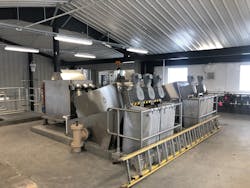Burns & McDonnell completes design, construction services for Consolidated Mutual Water Treatment Facility
LAKEWOOD, CO -- Burns & McDonnell recently completed design and construction services for a new residuals handling process and building at the Maple Grove Water Treatment Facility for The Consolidated Mutual Water Company. The 15.6 million-gallon-per-day (MGD) retrofitted facility began operations in February and serves nearly 100,000 customers in the surrounding Jefferson County communities.
Originally opened in 2008, the plant required a dewatering process upgrade for solids handling — the procedure for removing leftover solids created when raw water is treated and converted into clean drinking water. Burns & McDonnell was selected in 2017 to provide a solids management study and design-build services for the retrofit project.
"Throughout our company's nearly 100-year history, we relentlessly strive to provide world-class water services to our customers," says James Bohks, superintendent of water treatment at Consolidated. "This outstanding project epitomizes our commitment to excellence, and enables us to deliver affordable, clean and safe water to our customers for decades to come."
Partnering with a local construction contractor, Burns & McDonnell began construction in February 2019 and completed the project on schedule and under budget less than a year later in January 2020. The new 4,400-square-foot facility houses new dewatering equipment, including:
- Two 15,000-gallon solids storage tanks
- Two 105 gallon-per-minute (gpm), 535 pounds-per-hour volute dewatering presses
- Three 105 gpm progressive cavity pumps
- Two polymer preparation systems
- Ancillary feed valves, piping and controls
"The new efficiencies achieved at the Maple Grove Water Treatment Facility are a direct result of our design-build delivery method, which gave us the flexibility to successfully meet an expedited project schedule," says Mark Lichtwardt, senior vice president and general manager for Burns & McDonnell in Denver. "With a clear understanding of time constraints and outcome requirements, we designed and constructed a solution that gave new life to existing infrastructure while delivering a wide range of facility improvements."
The facility's state-of-the-art equipment and new dewatering method saves water in the treatment process, reduces odors and decreases heavy equipment noise levels. By siphoning water from the improved dewatering method and recycling and retreating leftover water, the new process provides a greater level of efficiency.
The design-build delivery method led by Burns & McDonnell enabled the procurement of dewatering equipment during the design phase, allowing the new equipment to be installed and operational — throughout peak demand season — in a temporary enclosure while the facility was under construction.
Burns & McDonnell has experience delivering more than 70 design-build water and wastewater critical infrastructure projects. Learn more about how Burns & McDonnell approaches design-build for water infrastructure.
SOURCE: Burns & McDonnell
